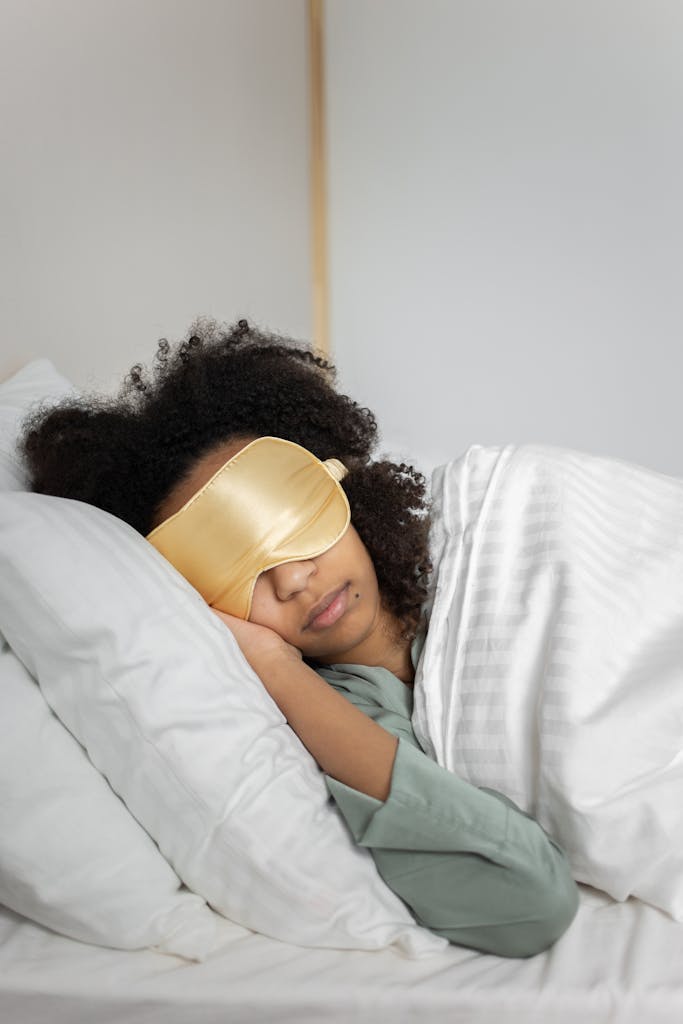
Ever found yourself wide awake at 2 AM, staring at the ceiling and wondering why you can’t just fall asleep like a normal person? Or maybe you’re one of those folks who hits snooze seventeen times and still feels like you need three more hours? Here’s the thing – you’re not broken, and you’re definitely not alone. You just haven’t found your perfect sleep rhythm yet.
Let’s figure this out together, shall we? By the end of this post, you’ll have your own personalized sleep schedule that actually works with your life, not against it.
Why Your Sleep Schedule Matters More Than You Think
Before we dive into the how-to, let’s talk about why this matters. When you nail your sleep schedule, everything else gets easier. You’ll think clearer, feel happier, have more energy, and even get sick less often. It’s like giving yourself a superpower, except it’s totally free and doesn’t require any special equipment!
Your body runs on something called a circadian rhythm – basically your internal clock that tells you when to feel awake and when to feel sleepy. Right now, your clock might be a little wonky, but the good news is you can retrain it. And yes, even if you’ve been a “night owl” your whole life, you can still create a schedule that works for you.
Step 1: Figure Out How Much Sleep You Actually Need

Here’s where we start getting personal. Forget everything you’ve heard about “8 hours for everyone” – that’s just an average, not a rule carved in stone.
Sleep Needs by Age
| Age Group | Recommended Sleep | Your Sweet Spot Might Be |
|---|---|---|
| 18-25 years | 7-9 hours | Could be anywhere from 6-11 hours |
| 26-64 years | 7-9 hours | Usually 6-10 hours works |
| 65+ years | 7-8 hours | Often 5-9 hours is perfect |
But here’s the real secret: your ideal amount might be different from your friend’s, your partner’s, or even what you think it should be. Some people are natural short sleepers (lucky them!) and feel amazing on 6 hours, while others need a solid 9-10 hours to function like human beings.
Finding Your Personal Sleep Sweet Spot
Try this simple experiment for a week (pick a week when you don’t have early morning commitments):
Day 1-3: Go to bed when you feel naturally tired and wake up without an alarm Day 4-7: Notice patterns – are you consistently sleeping 7 hours? 8? 9?
Keep a little sleep log like this:
| Night | Bedtime | Wake Time | Total Sleep | How You Felt (1-10) |
|---|---|---|---|---|
| Mon | 10:30 PM | 6:30 AM | 8 hours | 7 – pretty good |
| Tue | 11:00 PM | 7:00 AM | 8 hours | 8 – great! |
| Wed | 10:45 PM | 6:45 AM | 8 hours | 9 – amazing |
The amount that consistently makes you feel best? That’s your magic number.
Step 2: Discover Your Natural Sleep Type
Ready for a fun fact? You might be fighting against your natural sleep type without even knowing it! There are basically three types of sleepers, and knowing yours is like having a cheat code for better sleep.
The Three Sleep Types
| Sleep Type | Natural Bedtime | Natural Wake Time | Peak Energy | Best For |
|---|---|---|---|---|
| Early Birds (25% of people) | 9-10 PM | 5-6 AM | Morning | Morning workouts, early meetings |
| Night Owls (25% of people) | 11 PM-1 AM | 7-9 AM | Evening | Creative work, late projects |
| In-Betweeners (50% of people) | 10-11 PM | 6-8 AM | Mid-morning to afternoon | Most regular schedules |
Which one sounds like you? And be honest – not what you think you should be, but what feels natural when you don’t have external pressures.
If you’re not sure, think about this: when you’re on vacation with no schedule, what time do you naturally fall asleep and wake up? That’s your body’s honest answer.
Step 3: Work Backwards from Your Must-Wake Time

Alright, now we’re getting practical. Most of us can’t just wake up whenever we want (wouldn’t that be nice?), so let’s work with reality.
The Simple Calculation
Your ideal wake time – Your sleep need = Your ideal bedtime
Let’s say you need to wake up at 7 AM and you’ve discovered you need 8 hours of sleep: 7:00 AM – 8 hours = 11:00 PM bedtime
But wait – there’s more to consider! You also need time to actually fall asleep. Most people take 15-30 minutes to drift off, so add that buffer:
11:00 PM – 30 minutes = 10:30 PM (time to start your bedtime routine)
Adjusting for Different Schedules
| Your Situation | How to Adjust |
|---|---|
| Shift worker | Calculate based on your most consistent shift, use blackout curtains |
| Weekend warrior | Try to keep within 1 hour of your weekday schedule |
| Parent of young kids | Work with nap times, accept that it’ll be messy for a while |
| Student | Prioritize consistency during school, adjust gradually during breaks |
| Irregular work hours | Focus on sleep duration over timing, create portable routines |
Step 4: Factor in Your Sleep Cycles
Here’s where it gets really interesting. Your sleep happens in cycles of about 90 minutes, and you feel most refreshed when you wake up at the end of a cycle, not in the middle of one.
The 90-Minute Rule
Instead of just thinking “8 hours,” think in multiples of 1.5 hours:
| Sleep Cycles | Total Time | Good For |
|---|---|---|
| 4 cycles | 6 hours | Short sleepers, emergency situations |
| 5 cycles | 7.5 hours | Many adults’ sweet spot |
| 6 cycles | 9 hours | Longer sleepers, recovery periods |
So if you need to wake up at 7 AM and want 5 complete cycles: 7:00 AM – 7.5 hours = 11:30 PM bedtime
Try this for a week and see if you wake up feeling more naturally alert!
Step 5: Create Your Personal Sleep Schedule
Now let’s put it all together. Here’s your step-by-step process:
Your Sleep Schedule Formula
- Determine your wake time (based on your commitments)
- Subtract your ideal sleep duration
- Subtract 30 minutes for falling asleep
- Adjust to align with 90-minute cycles if possible
- Test and tweak for one week
Sample Schedules for Different Lifestyles
| Lifestyle | Wake Time | Sleep Need | Bedtime | Bedtime Routine Starts |
|---|---|---|---|---|
| Early Commuter | 6:00 AM | 8 hours | 9:30 PM | 9:00 PM |
| Standard Office | 7:00 AM | 7.5 hours | 11:00 PM | 10:30 PM |
| Flexible Schedule | 8:00 AM | 8.5 hours | 11:00 PM | 10:30 PM |
| Night Shift | 3:00 PM | 8 hours | 6:30 AM | 6:00 AM |
| Weekend Routine | 8:00 AM | 9 hours | 10:30 PM | 10:00 PM |
Your Perfect Interactive Sleep Time Calculator
⏰ Sleep Time Calculator
Figure out exactly when you should go to bed to wake up feeling refreshed and ready to take on the world!
🌙 How This Works
Your sleep happens in cycles of about 90 minutes each. When you wake up at the end of a complete cycle, you’ll feel much more refreshed than if you wake up in the middle of one. That’s the secret to feeling great in the morning!
Just tell us when you need to wake up, and we’ll calculate the perfect bedtimes for you.
When do you need to wake up?
This gives you time to wind down and fall asleep naturally
Or Choose Your Perfect Sleep Cycles
Pick any of these times to wake up feeling refreshed! The highlighted option matches your preferred sleep duration.
💡 Your Personalized Sleep Tips
| Sleep Cycles | Total Sleep Time | Best For | How You’ll Feel |
|---|---|---|---|
| 4 cycles | 6 hours | Short sleepers, emergency situations | Alert but might need a nap later |
| 5 cycles | 7.5 hours | Most adults, busy schedules | Refreshed and ready to go |
| 6 cycles | 9 hours | Long sleepers, recovery periods | Deeply rested and energized |
🎯 Pro Tips for Better Sleep
Start small: Don’t try to change your bedtime by 3 hours overnight. Shift it by 15-30 minutes every few days until you reach your goal.
Be consistent: Try to go to bed and wake up at the same time every day, even on weekends. Your body loves routine!
Listen to your body: These calculations are a great starting point, but you’re the expert on your own sleep. Adjust as needed to find what makes you feel amazing.
Making It Actually Work in Real Life
Okay, so you’ve got your perfect schedule on paper. But how do you actually stick to it when life gets in the way? Here are some gentle strategies that actually work:
Start Small and Be Patient
Don’t try to shift your bedtime by 3 hours overnight – that’s a recipe for frustration. Instead, move your bedtime 15-30 minutes earlier every few days until you reach your goal. Your body needs time to adjust, and that’s totally normal.
Create a Wind-Down Routine That You Actually Enjoy
Your bedtime routine doesn’t have to be Instagram-perfect. It just needs to signal to your brain that sleep time is coming. Here are some ideas:
15-30 minutes before bed:
- Dim the lights throughout your home
- Put away screens (or use blue light filters)
- Do something relaxing: read, stretch, listen to music, journal
- Prepare for tomorrow (lay out clothes, check your calendar)
5-10 minutes before bed:
- Get into comfortable sleepwear
- Set your phone aside (seriously, this one’s huge)
- Take a few deep breaths or do a quick meditation
Handle the Challenges That Come Up
Let’s be real – life isn’t always going to cooperate with your perfect sleep schedule. Here’s how to handle common obstacles:
| Challenge | Your Game Plan |
|---|---|
| Can’t fall asleep | Get up after 20 minutes, do a quiet activity until sleepy |
| Waking up too early | Stay in bed with eyes closed, practice relaxation |
| Weekend temptation | Allow 1 hour flexibility max, get back on track Sunday |
| Social events | Enjoy them! One late night won’t ruin everything |
| Travel/time zones | Start adjusting a few days before, stay hydrated |
| Stressful periods | Stick to your routine even more – it’s your anchor |
Fine-Tuning Your Schedule

Your first attempt probably won’t be perfect, and that’s completely okay! Think of this as an ongoing experiment where you’re the scientist studying your own sleep.
Signs Your Schedule Is Working
- You wake up feeling refreshed most days
- You fall asleep within 30 minutes of lying down
- You don’t need multiple alarms to wake up
- Your energy stays steady throughout the day
- You’re not desperately craving naps
Signs You Need to Adjust
- You’re lying awake for more than 30 minutes regularly
- You need multiple cups of coffee to function
- You feel groggy even after a full night’s sleep
- You’re getting sick more often
- Your mood is consistently low
Quick Adjustments You Can Try
If you can’t fall asleep: Move bedtime 30 minutes later If you’re waking up groggy: Try going to bed 30 minutes earlier or later (to hit a different sleep cycle) If you’re waking up too early: Make your room darker, avoid afternoon caffeine If you need more sleep on weekends: You might need more sleep during the week
Special Considerations for Different Life Stages
Your sleep needs aren’t set in stone – they change as your life changes, and that’s perfectly normal.
Life Stage Sleep Adjustments
| Life Stage | Common Changes | How to Adapt |
|---|---|---|
| College/Young Adult | Irregular schedule, social pressure | Focus on sleep debt recovery, nap strategically |
| New Parent | Interrupted sleep, exhaustion | Sleep when baby sleeps, tag-team with partner |
| Career Building | Long hours, stress | Protect your sleep time fiercely, it’s not selfish |
| Midlife | Hormonal changes, family demands | Be flexible but consistent, prioritize sleep quality |
| Retirement | More flexibility, possible health issues | Maintain routine, get morning sunlight |
Your Action Plan: Making This Happen
Ready to put this all into practice? Here’s your week-by-week plan:
Week 1: Discovery
- Track your current sleep patterns
- Notice your natural tendencies
- Don’t change anything yet, just observe
Week 2: Gradual Shift
- Start moving toward your calculated bedtime
- Shift by 15-30 minutes every couple of days
- Begin a simple wind-down routine
Week 3: Consistency
- Stick to your new schedule, even on weekends
- Fine-tune based on how you’re feeling
- Address any obstacles that come up
Week 4: Evaluation and Adjustment
- Assess what’s working and what isn’t
- Make small tweaks if needed
- Celebrate your progress!
Remember: Progress, Not Perfection
Here’s the most important thing I want you to remember: you don’t have to be perfect at this. Some nights you’ll stay up too late, some mornings you’ll hit snooze, and sometimes life will completely mess up your schedule. That’s not failure – that’s being human.
The goal isn’t to become a sleep robot. It’s to create a schedule that works for your real life and makes you feel better most of the time. Every small step toward better sleep is worth celebrating.
You might be surprised by how much better you feel when you finally work with your body’s natural rhythms instead of against them. Better sleep leads to better days, which lead to a better life. And you absolutely deserve that.
So start tonight – even if it’s just dimming the lights 30 minutes before your usual bedtime. Your future well-rested self is going to thank you for taking this step. You’ve got this!



Pingback: 15 Perfect Bedroom Setup for Quality Sleep